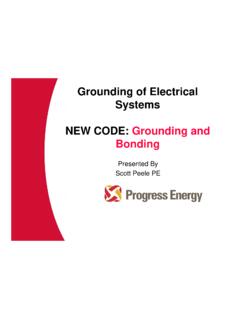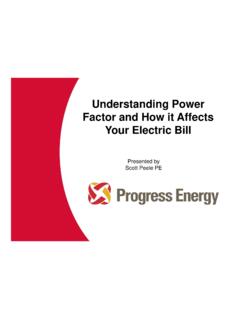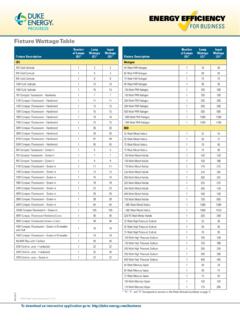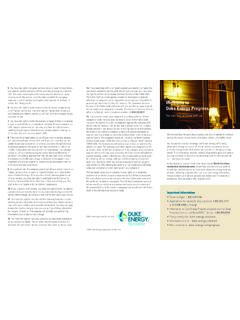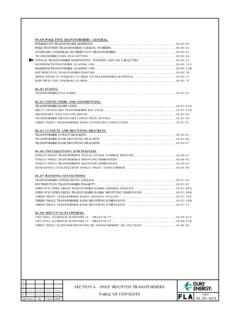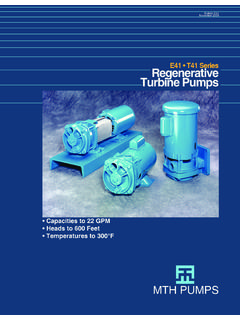Transcription of Progress Energy Generating Plants
1 Progress Energy Generating PlantsProgress Energyoperates power- Generating facilities at 32 sites in North Carolina, South Carolina and Florida. Together, the company s power plant fleet is capable of Generating approximately 23,000 megawatts of electricity. Progress Energy operates a diverse mix of plant technologies and fuel sources,including hydroelectric, nuclear, coal, natural gas and oil. This fuel diversityenables the company to minimize cost impacts from any one fuel source and ensures reliable power for our residential, commercial, industrial andwholesale customers.
2 Electricity cannot be stored. That means every minute of every day, ProgressEnergy s Generating Plants must match changing customer power demands. And each plant has an important role in the company s mission to provide safe,reliable and cost-effective power to the the Southeast with reliable power productionTable of ContentsGenerating Technologies1 Illustrations3 Glossary8 Florida9 PLANTTECHNOLOGYA nclotesteam11 Avon Parkcombustion turbine11 Bartowcombined cycle, combustion turbine12 Bayborocombustion turbine12 Crystal Rivernuclear, steam13 DeBarycombustion turbine13 Higginscombustion turbine14 Hinescombined cycle14 Intercession Citycombustion turbine15 Rio Pinarcombustion turbine15 Suwanneecombustion turbine , steam16 Tiger Baycombined cycle16 Turnercombustion turbine17 University of Florida Cogeneration combustion turbine17 North Carolina/South Carolina19 PLANTTECHNOLOGYA shevillecombustion turbine , steam21 Blewetthydroelectric, combustion turbine21 Brunswicknuclear22 Cape Fearcombustion turbine , steam22 Darlington ( )
3 Combustion turbine23 Harrisnuclear23 Leecombustion turbine , steam24 Marshallhydroelectric24 Mayosteam25 Morehead Citycombustion turbine25 Robinson ( )nuclear, steam, combustion turbine26 Roxborosteam26 Smithcombined cycle, combustion turbine27 Suttoncombustion turbine , steam27 Tilleryhydroelectric28 Waltershydroelectric28 Waynecombustion turbine29 Weatherspooncombustion turbine29 Generating TechnologiesFour combined-cycleplantsprovide a total of 4,334megawatts of generatingcapacity. Combined-cycletechnology offers an efficientsource of electricity with outstanding reliability.
4 Withattractive environmental andoperating characteristics, ourcombined-cycle Plants makeup a valuable part of ProgressEnergy s generation mix. 2 Our coal- and oil-powered steamplants generate 8,405 megawatts of power to meet thedaily Energy needs of our customers. Maintainingdiversity in our fuel mix allows us to adjust quickly toever-changing Energy prices and ensures ProgressEnergy scustomers power that s not only reliable,but also affordable. Progress Energy s 91 combustion turbineunits have a combined generation capacityof 5,659 megawatts of power. These high-tech facilities can reach full power quickly,which enables Progress Energy to respondto peak demands and keep the cities andtowns we serve running like Energy owns and operates fourhydroelectricplants along rivers throughoutNorth Carolina.
5 These stations provide valued,emission-free generation to the , our hydroelectric Plants provide 225 megawatts of reliable, environmentallyfriendly power generation to complement ourenergy generation representsabout 19 percent of Progress Energy sinstalled generation capacity 4,354megawatts enough electricity to powermore than million homes. In additionto beingreliable, cost-effective andresource-efficient, nuclear Energy is asafe andclean Energy source that helpsmeet the increasing Energy demands oftoday s technology-driven TechnologiesNote: Not all coal Plants have SCRs and collectionCoalBoilerPrecipitatorScrubber StackTurbineGeneratorTransformerPulveriz erAir fanElectricityCool water sourcePumpSteam linesCondensersteam (coal, oil)
6 5 Cool water sourceGeneratorTransformerSteam turbineGeneratorTransformerNatural gas or oilPumpCondenserElectricityHeat exhaustElectricityHeat recovery steam generatorCondensed water Steam lineAir intakeTurbinecombined cycle6 Generating TechnologiesGeneratorTransformerElectric ityAir intakeCompressorCombustion chambersNatural gasOilHeat exhaustTurbineWatercombustion turbineGenerating TechnologiesTu r b i n ePenstockControl GateTransformerGeneratorPower houseElectricityOutflowIntakeReservoirDa mhydroelectric78 Baseload plantA Generating plant that typically runs 90 to 100 percent of the time to meet basic, constant electricity vessel, usually consisting of metal sheets andtubes, in which water is boiled to produce water reactor (BWR) A type of nuclear reactorwhich boils water directly in the core to be sent to a turbineto generate black or brownish solid combustible substanceformed by the partial decomposition of vegetable matterwithout free access of air and under the influence of mois-ture, and often intense pressure and temperature.
7 The rank of coal (anthracite, bituminous, subbituminous and lignite) is determined by its heating large heat exchanger designed to coolexhaust steam so that it can be returned to the heat sourceas water. Containment buildingA gastight shell or other enclosurearound a nuclear reactor that confines fission gateGates that open on a dam and allow gravity to pull water into the intake rodA rod, plate or tube containing a material thatreadily absorbs neutrons, slowing the fission towerA heat exchanger designed to aid in thecooling of water used to cool exhaust steam exiting the turbines of a power plant.
8 Cooling towers transfer exhaustheat into the air instead of into a body of barrier built across a waterway to control the flow of machine that transforms mechanical energyinto electric recovery generatorA heat exchanger that uses theheat rejected from a gas turbine . The waste heat is capturedand is then used as input heat to a steam turbine to moreefficiently create on a dam that open and allow gravity to pullthe water through the plantA Generating plant that typically runsabout 50 to 60 percent of the time to meet electricity demandthat exceeds the basic, continuous gasNaturally occurring mixtures of hydrocarbongases and vapors, the more important of which are methane,ethane, propane, butane, pentane and hexane.
9 Peaking plantA Generating plant that typically runs lessthan 10 percent of the time to meet relatively short periods ofheightened electricity demand on the hottest and coldest pipeline that leads from a reservoir to a turbineallowing water to build pressure as it flows through this hydroelectric plant structure housing pollution control device that collects particlesfrom gaseous emissions by mechanical or electrical water reactor (PWR) A type of power producing reactor which keeps the water surrounding thecore under pressure. When the pressurized water is heatedby the reactor, it is sent to a heat exchanger and it boilswater that is kept at a lower pressure.
10 This steam is thensent to a turbine to generate electricity. PulverizerA machine that reduces coal to a vesselAn apparatus in which the nuclear fissionchain reaction may be initiated, maintained and controlled, so that the accompanying Energy is released at a specifiedrate. It includes fuel (uranium), a moderating material, controlelements and holding area, natural or artificial, used tostore, regulate or control device that uses a liquid spray or solid sorbentto remove aerosol and gaseous pollutants from an air stream. The gases are removed either by absorption or by chemicalreaction.
